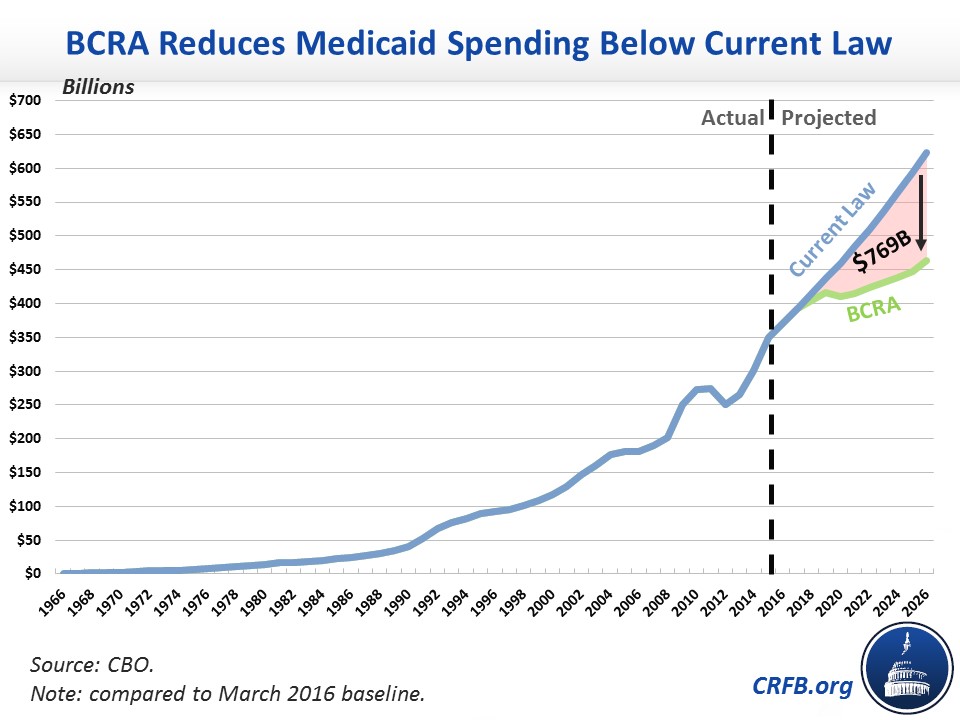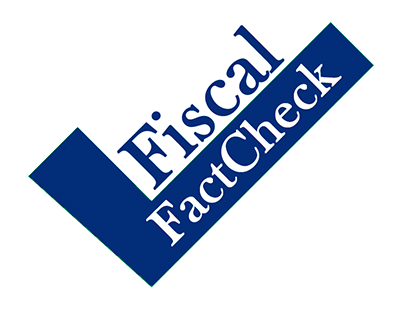Is There a Medicaid Spending Increase Under the Senate Health Bill?
President Donald Trump recently claimed on Twitter that Medicaid spending will go up under the Senate's Better Care Reconciliation Act (BCRA). It is true that Medicaid spending will grow under the BCRA in nominal dollars. But it would shrink as a share of Gross Domestic Product (GDP) and relative to current law – which is how policies are most commonly measured under current budget practice. The President's statement is lacking context.
The President's graph, displayed in his tweet above, is correct in a narrow sense – other than a dip in 2020, nominal Medicaid spending would continue to rise under the BCRA. Medicaid is projected to cost around $390 billion this year, and under the BCRA, its cost would rise to around $460 billion in 2026.*
However, the nominal growth in Medicaid spending occurs despite the BCRA, not because of it. Under current law, nominal Medicaid costs will increase by roughly $230 billion between now and 2026 – largely (but not entirely) due to the rising cost of providing the same level of benefits over time. Under the BCRA, nominal Medicaid costs would instead rise by closer to $70 billion.
In order to measure the impact of legislation, the Congressional Budget Office (CBO) and other scorekeepers compare a bill's projected outcome to a “current law” baseline showing what would happen without the bill.
By this measure, the BCRA results in significant cuts. Relative to current law, CBO estimates the BCRA would reduce Medicaid spending by roughly $770 billion over the next decade.
This savings is largely the result of phasing out enhanced funding for states that adopt the Affordable Care Act's Medicaid expansion and capping per capita spending growth for each state (see our description of the major changes of the bill or its cost estimate).

Certainly, the legislation reduces Medicaid spending relative to current law. The bill also reduces Medicaid spending relative to today as a share of GDP – from 2.0 percent in 2017 to 1.7 percent of GDP in 2026. In real, inflation-adjusted dollars, the legislation holds spending roughly flat over the next decade.
Importantly, it is not inherently wrong to describe a policy as slowing the growth of a program, rather than as cutting spending. A policy can both slow the growth of spending relative to today and cut spending relative to what it otherwise would have been. Showing the effect of legislation without showing the result can sometimes lead to a misleading picture.
Medicaid spending, like Social Security and Medicare spending, is projected to grow over time – in real dollars, as a percent of GDP, in per-person costs, and in the value of benefits provided. Each of these programs will require reforms, and if enacted soon such reforms can ensure overall benefits remain at least as generous (at least on average) as they are today.
Yet one cannot have it both ways. If the law is not considered a spending cut, it also cannot be considered deficit reduction. The White House has bragged the BCRA "would cut deficits by $300 billion and cut taxes by $700 billion." That is an appropriate summary of CBO's findings, but inconsistent with the argument that the legislation would not cut Medicaid.
Under the logic implied by the President's graph, debt would rise by $9 trillion under the BCRA, even though the debt increase is due to our underlying unsustainable fiscal situation, not the bill itself.
In the final analysis, it is true that in most years nominal Medicaid spending would continue to grow under the BCRA. But it wouldn’t grow in real dollars, and would actually shrink as a share of the economy. Moreover, the nominal spending increase is not because of the legislation; it is in spite of it. Relative to current law, the bill reduces Medicaid costs. The President's tweet therefore lacks important context.
Our Rating: Lacks Context
*The President’s graph used CBO’s January 2017 baseline, while CBO’s estimate of BCRA is measured against the March 2016 baseline because it’s being considered under reconciliation instructions that require savings to be estimated relative to March 2016 projections. Subsequent to the President’s graph, CBO released updated projections with slightly higher Medicaid spending.


